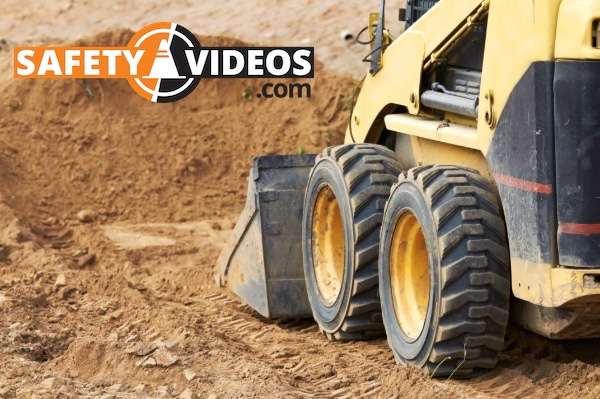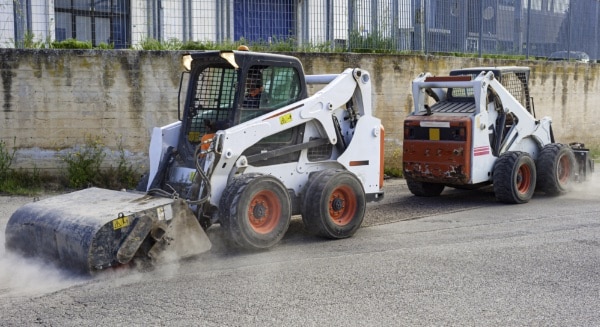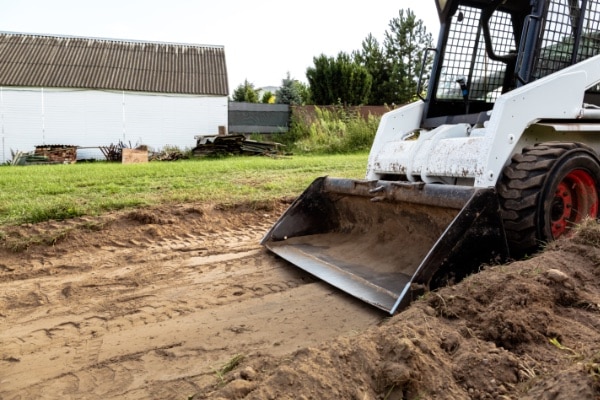35+ Best Skid Steer Safety Tips – [Updated for 2023]

Skid steers are a common type of equipment that can be found on the job site in a variety of industries. They are smaller in size than other pieces of machinery, but they still come with risks. Recognizing the safety hazards that come with operating a skid steer will keep you and everyone on the site safe. By following these skid steer safety tips, along with having your employees watch a good skid steer safety certification video will help keep your operators safe, and your company in regulatory compliance.
What Is a Skid Steer?
A skid steer is a versatile machine that is frequently used in construction or on farms and ranches because of its ability to move quickly in and out of tight spaces. They also come with many options for attachments that help operators complete a wide range of tasks with just one machine. These pieces of heavy equipment have an almost unlimited range of use case scenarios.
However, injuries and fatalities from these machines are not uncommon. They can be extreme or even fatal due to being crushed or mangled by different parts of the machine in an accident. Operators must be able to recognize potential hazards, including secondary factors such as mud, ice, and slick work areas that can cause an accident, and know how to take necessary safety precautions.

Necessary Skid Steer Safety Tips:
- Always follow the instructions in the operator’s manual and don’t operate a skid steer without the necessary training.
- Don’t work underneath the arms or bucket of the skid steer if they are raised, even if it is turned off.
- Put the bucket down to the ground before getting off of the machine.
- Organize your workstation so that it does not block other workers from a fire exit.
- Always keep your line of sight clear. Stop working if you no longer see someone who was working near the machine.
- Don’t overload the machine with a fresh load. In the event the machine struck the ground, the operator could be jostled out of the machine.
- Always keep the bucket on the ground while moving.
- Always keep your seat belt fastened or use the restraint bar if one is available.
- Regularly inspect safety devices before using them. Inspection should include rollover protection, guards, seatbelts, and interlocked controls. Never remove or alter any safety features.
- Stay seated while operating the machinery.
- Never carry people or lift them with any other attachment on the machine.
- There should always be measures in place to prevent the lift arms from lowering when they’re not supposed to as the operator is entering and exiting the machine. Provide handholds to help operators safely enter and exit the machine.

Skid Steer Loader Safety
Being familiar with skid steer safety tips will keep you and other workers safe on the job. Make sure to follow all proper maintenance procedures and operation procedures in order to do so.
The Basics
- Understand how to tie down, transport, and unload the loader safely. Enter after the bucket has been lowered.
- Clean the foot controls when needed. Keep them free of any debris, mud, snow, or ice to prevent causing an accident and violating safety guidelines.
- Keep control levers positioned between the lift arms and in front of the lift arm pivot points. This prevents the lift arm supports, loader bucket, and other attachments from crushing or pinning operators when the machine shouldn’t be moving.
- Keep the left rear tire and right rear tire flat on the ground at all times. This will prevent the machine from hitting the ground rear end first and jostling the operator out of the operator’s compartment.
- Never travel across slopes or load and unload the machine where the ground is not level for safe operation. Having the machine unbalanced could be dangerous in the event the loader stalled. If the lift arms are up, you can become stuck in the machine.
- Never attempt to operate the machine from outside of the operator’s compartment. Only operate from the operator’s seat. This ensures that the operator can safely reach all of the controls without the risk of them losing their balance.
- Don’t alter the lift arm support. Altering the lift arm supports can lead to injury or death in an accident because they prevent the operator from exiting the machine.

Operation
- Read and follow safe operating procedures to keep yourself and others safe while operating a skid steer. You should also be familiar with warning decals that are posted on the machine.
- For safe operation you should:
- Be familiar with skid steer loading safety, including the area and the use of the controls.
- Know how to load, tie down, and unload the skid steer loader.
- Enter the machine while the bucket is lowered.
- Wear ear and head protection.
- Use safety features including grab handles and safety treads to get in and out of the machine.
- Use the seat belt and seat bar.
- Drive straight with the heavy end of the loader facing up.
- Never carry passengers in or on the skid steer.
- Never use the raised bucket as a platform to move workers.
- Always watch for overhead power lines when you have the bucket raised.
- Use the parking brake and lower the bucket before getting off the machine.
- Never let children operate the skid steer or sit in the operator’s cab while performing maintenance.
- Only enter and exit the machine when it is turned off, the lift arms are down, and any attachment lowered to the ground.
- Never exceed the maximum load capacity. Loads should also be evenly distributed in the bucket and other attachments. Lift the loads slowly.
Maintenance Procedures
Before performing any type of maintenance, be sure to read the owner’s manual carefully for instructions on how to maintain each skid steer loader. In order to follow proper maintenance procedures, you must adhere to all safety warnings. This includes but is not limited to using safety interlocked controls to block all equipment manufactured and parts that could potentially release stored energy while completing maintenance tasks.
Remember to never disable or remove any safety devices, shields, or guards unless it’s specified it’s part of the manufacturer’s written approval. You should then set the parking brake and lower the bucket. In the event that the loader can’t receive maintenance with the bucket on the ground, you should use the arm lift supports.
Always inform all other workers in the area that maintenance is being done. Keep all children out of the area, including out of the operator’s cab.

Pre-Operation Check
Making sure the skid steer loader you are about to operate is in working condition is the first step in preventative safety. Ensuring that every skid steer is in the best shape before being operated will reduce the risk of injury and the number of times you may have to enter and exit the machine to fix things. Before use, you should check:
- Hydraulic fluid
- Fuel and oil
- Cooling systems fluid
- Operator cab
- Seat belt
- Seat bar
- Lift arms
- Cylinder pivot points
- Safety interlock systems
- Tires
If there are ever any issues with the hydraulic system, including a hydraulic system leak, you should repair it immediately. In the event of a leaking hydraulic system, the lift arms can lower rapidly, potentially causing injury or damaging property.
Hazards Associated with Operating Skid Steers
Skid steer loaders account for injuries and deaths each year, most of which are the result of individuals being crushed between the frame of the machine and the lift arm hydraulic cylinder. In these cases, the lift arm control lever is often accidentally activated by hand or foot controls. Understanding the hazards associated with the machine will make it easier to stay safe during operation.
Struck-by hazards are a serious risk to workers who are nearby a skid steer in motion. These machines are typically operated in high-traffic areas of a job site, making it more difficult for operators to keep an eye on everyone in the area. Reversing is often necessary, making blind spots a common factor in stuck-by accidents.
Crushed-by hazards tend to be a major concern while operating because workers on the ground can potentially be pinned or crushed between the machine and another object. Operators may also be crushed by their own machine if they get pinned between the bucket and the frame or between one of the lift arms and the frame.
Being crushed can lead to crushing injuries involving hands, arms, feet, and legs that sometimes have to be amputated due to the severity of the injuries. Deaths due to crushing injuries also occur. These machines are designed for operators to enter and exit through the front and over the bucket.
Tip overs or rollovers are also a leading cause of injuries and fatalities. These machines are the most stable when the center of gravity is kept on the basis of stability. Operating the machine on steep terrain while hauling loads beyond its maximum capacity or turning at too high of a speed could cause the machine to tip or roll over. Keeping the bucket low will maintain a low center of gravity.
Pinch points are also common and can lead to injuries to any body parts.

Machine Safety Devices
Most skid loader-related injuries can be avoided by using and maintaining the manufacture-installed machine safety features. The Occupational Safety and Health Administration (OSHA) has guidelines and regulations that encourage these devices to be installed and used. These skid steer safety devices include: lift arm supports, interlock system controls, seat belts, and the rollover protection structure.
Lift Arm Supports
Lift arm supports are usually provided by the manufacturer to eliminate the risk of skid loader accidents and fatalities. These are recommended when work needs to be done around the machine or when workers need to move around it while the bucket is in the raised position and controls are unattended.
Newer skid steer loader models come with pin or strut supports that can be used while someone is sitting in the operator’s cab.
Interlocked Controls
This system requires a seated and seat belted operator before the skid steer can be moved. Some skid steers even require that the seat belts are connected. Some systems may be able to automatically detect when the operator leaves the seat and shuts down the machine.
This system is similar to the one used in riding lawn mowers. Some skid steer models even come with a safety restraint bar similar to the ones found on roller coasters. These restraint bars need to be lowered in front of the operator in order for the skid steer to be operated.
Why Are Seat Belts A Big Part of Skid Steer Safety?
Seat belts restrain the individual sitting in the operator’s seat to keep them safe within the zone of protection on skid steers that have a rollover protection structure built in. When seat belts are included as part of the interlocking system, they prevent operators from getting stuck being crushed between the lift arms and the frame of the skid steer.
This essential safety feature also prevents operators from being able to reach out of the machine or from being thrown out of the skid steer cab and into rough terrain.
Rollover Protection and Side Screens
The rollover protection structure and side screens are what prevent operators from being tossed out of the machine or being crushed in a rollover. The rollover protection is part of an enclosed cab design that comes with side screens. These screens are placed on the side and the rear and are made out of metal grate to keep the operator’s head inside the cab, along with their hands and other body parts.

OSHA Standards
The Occupational Safety and Health Administration (OSHA) provides regulations designed for preventing injuries and to keep workers up-to-date on how to properly use construction equipment, including skid steers on the job.
End loader buckets and any other attachments should either be lowered or blocked to prevent moving while being repaired or when not in use. All controls should be in a neutral position and the brakes set when the motor is stopped unless the work being done requires otherwise.
Scissor points are considered a hazard to operators during normal operation, which makes it mandatory to keep them guarded for skid steer safety.
Seatbelts must be provided and should meet all standards of the Society of Automotive Engineers (SAE).
Equipment should be equipped with rollover protection that meets the minimum performance standards prescribed in the guidelines or should be designed or modified and installed in a way that supports a minimum of two times the weight of the equipment at the point of impact.
No modifications or additions can be made without the manufacturer’s permission to any part of the machine that affects the capacity or skid steer loader safety. In the event that modifications are made, the decals and tags should be changed to reflect the changes.
The Occupational Safety and Health Administration requires that all employers and employees in the construction industry and other industries follow these guidelines to guarantee skid steer safety. These guidelines also apply to mechanized equipment, marine operations, and motor vehicles.
SAE Standards
The Society of Automotive Engineers (SAE) developed a standard for skid steer manufacturers. These standards permit operation under laws intended to keep all employers and employees safe. This standard requires skid steer loaders to:
- Provide warnings, operator’s instructions, and maintenance instruction procedures. Maintenance instruction plates should be changed if there are any modifications or changes made to the machine.
- Equip every skid steer with seat belts, rollover protection, and side screens to keep the operators head inside the machine in case of an accident.
- Implement measures that prevent the lift arms from lowering while operators are getting into or out of the machine.
- Provide restraint bars and stapes that allow operators to enter and exit the skid steer loaders safely.
- Ensure there is an emergency exit through two openings.
- Implement safety signs and instructions to warn workers of potential hazards for operation and maintenance.
Keeping Your Site Safe with a Skid Steer Loader
Skid steer loaders can be operated as construction equipment without incident. However, they still present enough risks that require workers to be familiar with these skid steer safety tips.
A lack of training or not following operator instructions can cause injury or death to workers. Make sure to be familiar with all the hazards and requirements that come with operating skid steer loaders for preventing injuries and keeping people safe.